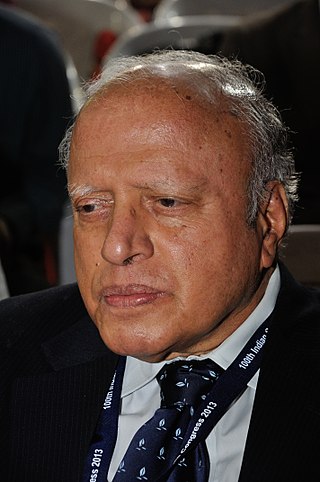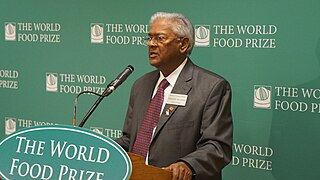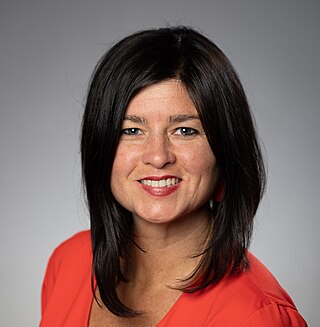Related Research Articles

Triticale is a hybrid of wheat (Triticum) and rye (Secale) first bred in laboratories during the late 19th century in Scotland and Germany. Commercially available triticale is almost always a second-generation hybrid, i.e., a cross between two kinds of primary (first-cross) triticales. As a rule, triticale combines the yield potential and grain quality of wheat with the disease and environmental tolerance of rye. Only recently has it been developed into a commercially viable crop. Depending on the cultivar, triticale can more or less resemble either of its parents. It is grown mostly for forage or fodder, although some triticale-based foods can be purchased at health food stores and can be found in some breakfast cereals.

The Green Revolution, or the Third Agricultural Revolution, was a period of technology transfer initiatives that saw greatly increased crop yields. These changes in agriculture began in developed countries in the early 20th century and spread globally till the late 1980s. In the late 1960s, farmers began incorporating new technologies such as high-yielding varieties of cereals, particularly dwarf wheat and rice, and the widespread use of chemical fertilizers, pesticides, and controlled irrigation.
Norin 10 wheat (小麦農林10号) is a semi-dwarf wheat cultivar with very large ears that was bred by Gonjiro Inazuka at an experimental station in Iwate Prefecture, Japan. Its parents were a semi-dwarf Japanese landrace that may have originated in Korea in the 3rd or 4th century AD, and two varieties from the USA. In 1935 it was registered as a numbered cultivar by the Japanese Ministry of Agriculture and Forestry Nōrinshō (農林省).

Norman Ernest Borlaug was an American agronomist who led initiatives worldwide that contributed to the extensive increases in agricultural production termed the Green Revolution. Borlaug was awarded multiple honors for his work, including the Nobel Peace Prize, the Presidential Medal of Freedom and the Congressional Gold Medal, one of only seven people to have received all three awards.

The International Maize and Wheat Improvement Center is a non-profit research-for-development organization that develops improved varieties of wheat and maize with the aim of contributing to food security, and innovates agricultural practices to help boost production, prevent crop disease and improve smallholder farmers' livelihoods. CIMMYT is one of the 15 CGIAR centers. CIMMYT is known for hosting the world's largest maize and wheat genebank at its headquarters in Mexico.

Mankombu Sambasivan Swaminathan was an Indian agronomist, agricultural scientist, plant geneticist, administrator, and humanitarian. Swaminathan was a global leader of the green revolution. He has been called the main architect of the green revolution in India for his leadership and role in introducing and further developing high-yielding varieties of wheat and rice. Swaminathan's collaborative scientific efforts with Norman Borlaug, spearheading a mass movement with farmers and other scientists and backed by public policies, saved India and Pakistan from certain famine-like conditions in the 1960s. His leadership as director general of the International Rice Research Institute (IRRI) in the Philippines was instrumental in his being awarded the first World Food Prize in 1987, recognized as one of the highest honours in the field of agriculture. The United Nations Environment Programme has called him "the Father of Economic Ecology".

The World Food Prize is an international award recognizing the achievements of individuals who have advanced human development by improving the quality, quantity, or availability of food in the world. Conceived by Nobel Peace Prize laureate Norman Borlaug and established in 1986 through the support of General Foods, the prize is envisioned and promoted as the Nobel or the highest honors in the field of food and agriculture. It is now administered by the World Food Prize Foundation with support from numerous sponsors. Since 1987, the prize has been awarded annually to recognize contributions in any field involved in the world food supply, such as animal science, aquaculture, soil science, water conservation, nutrition, health, plant science, seed science, plant pathology, crop protection, food technology, food safety, policy, research, infrastructure, emergency relief, and poverty alleviation and hunger.
The cereal grain wheat is subject to numerous wheat diseases, including bacterial, viral and fungal diseases, as well as parasitic infestations.

Stem rust, also known as cereal rust, black rust, red rust or red dust, is caused by the fungus Puccinia graminis, which causes significant disease in cereal crops. Crop species that are affected by the disease include bread wheat, durum wheat, barley and triticale. These diseases have affected cereal farming throughout history. The annual recurrence of stem rust of wheat in North Indian plains was discovered by Prof. K.C. Mehta. Since the 1950s, wheat strains bred to be resistant to stem rust have become available. Fungicides effective against stem rust are available as well.

Elvin Charles Stakman was an American plant pathologist who was a pioneer of methods of identifying and combatting disease in wheat. He became an internationally renowned phytopathologist for his studies of the genetics and epidemiology of stem rust. Stakman is credited with improving crop yields both in North America and worldwide as part of the Green Revolution.
Subrahmaniam Nagarajan is an Indian wheat pathologist. He studied in Chennai till high school and completed his early education at the Agriculture College, Coimbatore, then pursued his masters at the Indian Agriculture Research Institute, New Delhi and received his doctorate in Agriculture from the Delhi University. He is the Project Director of the All India Wheat program and author of more than 120 research papers, 50 book chapters and two textbooks.

Ug99 is a lineage of wheat stem rust, which is present in wheat fields in several countries in Africa and the Middle East and is predicted to spread rapidly through these regions and possibly further afield, potentially causing a wheat production disaster that would affect food security worldwide. In 2005 the noted green revolution pioneer Norman Borlaug brought great attention to the problem, and most subsequent efforts can be traced to his advocacy. It can cause up to 100% crop losses and is virulent against many resistance genes which have previously protected wheat against stem rust.
Crop diversity or crop biodiversity is the variety and variability of crops, plants used in agriculture, including their genetic and phenotypic characteristics. It is a subset of and a specific element of agricultural biodiversity. Over the past 50 years, there has been a major decline in two components of crop diversity; genetic diversity within each crop and the number of species commonly grown.
The Norman E. Borlaug International Symposium, commonly known as the Borlaug Dialogue, is an annual international symposium tackling the topic of global food security organized by The World Food Prize Foundation. Past symposia have focused on the promises and challenges presented by biofuels for global development, the dual challenges of malnutrition and obesity, water insecurity and its impact on development and stability in the Middle East, and the possibility of replicating the Green Revolution.

Dr. Sanjaya Rajaram was an Indian-born Mexican scientist and winner of the 2014 World Food Prize. He was awarded this prize for his scientific research in developing 480 wheat varieties that have been released in 51 countries. This innovation has led to an increase in world wheat production – by more than 200 million tons – building upon the successes of the Green Revolution. The Government of India awarded him India's fourth- and third-highest civilian awards Padma Shri (2001) and Padma Bhushan (2022).

Dilbagh Singh Athwal was an Indian-American geneticist, plant breeder and agriculturist, known to have conducted pioneering research in plant breeding. He was a professor and the Head of the Department of Plant Breeding at Punjab Agricultural University and an associate of Norman Borlaug, a renowned biologist and Nobel Laureate, with whom he has collaborated for the introduction of high-yielding dwarf varieties of wheat.
Ronnie Coffman is an American plant scientist and professor. He is director of numerous research projects dedicated to international agriculture, food security and gender equity in agriculture. He received the World Agriculture Prize in 2013. He was named a 2019 Fellow of the American Association for the Advancement of Science.
2Blades is an agricultural phytopathology non-profit which performs research to improve durable genetic resistance in crops, and funds other researchers to do the same. 2Blades was co-founded by Dr. Roger Freedman and Dr. Diana Horvath in 2004.

Sarah Davidson Evanega is an American researcher who works in plant sciences, a public policy influencer and a science communicator, especially relating to agricultural biotechnology. She is a professor at the Boyce Thompson Institute for Plant Research (BTI), and an adjunct professor in the School of Integrative Plant Sciences, Cornell University. She is the director of the Alliance for Science and was awarded the 2021 Borlaug CAST Communication Award.
The Valle del Yaqui or Yaqui Valley is a highly productive agricultural area in Sonora. Durum wheat is a major crop. However, the crop is highly fertilized, and is a significant source of nitrous oxide, a powerful greenhouse gas.
References
- ↑ "Sounding the Alarm on Global Stem Rust" (PDF). Borlaug Global Rust Initiative. 2005-05-29. Archived from the original on 2011-07-18. Retrieved 2011-01-11.
- ↑ Dahm, Madeline (2020-12-09). "Let there be food to eat". CIMMYT . Retrieved 2020-12-11.
- ↑ Barker, Bruce (2010-11-16). "The Race to Beat UG99 Stem Rust". Top Crop Manager. Retrieved 2011-01-11.
- ↑ "Dr. Norman Borlaug to celebrate 95th birthday on March 25". The World Food Prize Foundation. 2009-03-04. Retrieved 2011-01-11.
- ↑ "About the BGRI" . Retrieved 20 July 2011.